Management Analysis: Baggage Blunders at Heathrow Airport Terminal 5
VerifiedAdded on 2020/03/04
|10
|2556
|51
Report
AI Summary
This report analyzes the baggage handling issues at Heathrow Airport's Terminal 5, focusing on the management failures and the implementation of different control systems. The report examines the problems caused by inexperienced workers, faulty systems, and inadequate staffing, which led to significant delays and customer dissatisfaction. It discusses various control systems, including feed-forward, concurrent, and feedback controls, evaluating their suitability for the situation. The report then explores corrective actions, such as hiring additional staff, improving check-in services, and updating computer systems. Furthermore, it assesses the effectiveness of the implemented strategies and highlights lessons learned for other organizations. The analysis emphasizes the importance of information control, customer interaction, and benchmarking in preventing and resolving similar issues, ultimately concluding that organizations should prioritize customer satisfaction and effective planning to achieve their objectives. The report uses concepts of leadership and management to analyze the case study.
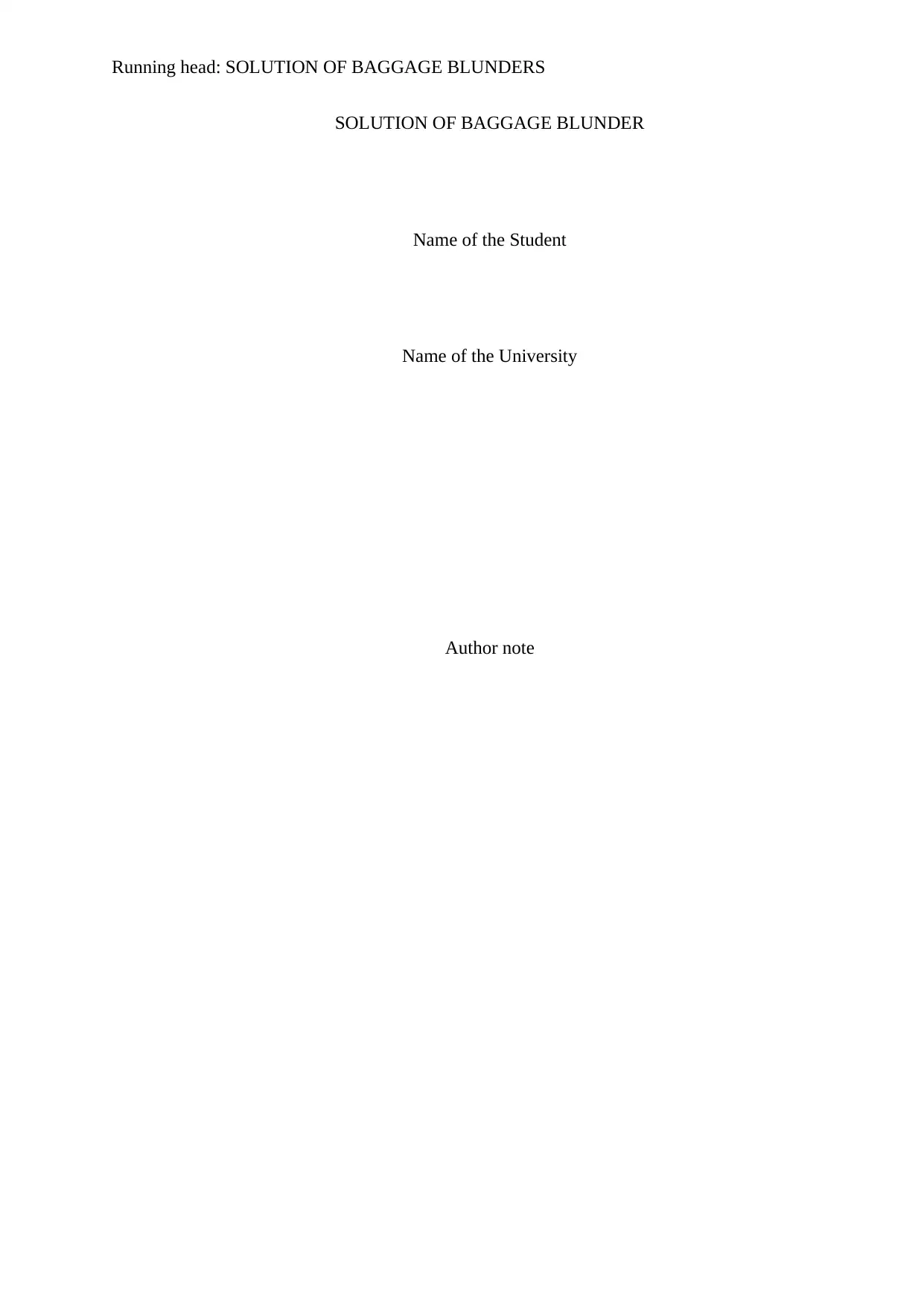
Running head: SOLUTION OF BAGGAGE BLUNDERS
SOLUTION OF BAGGAGE BLUNDER
Name of the Student
Name of the University
Author note
SOLUTION OF BAGGAGE BLUNDER
Name of the Student
Name of the University
Author note
Paraphrase This Document
Need a fresh take? Get an instant paraphrase of this document with our AI Paraphraser
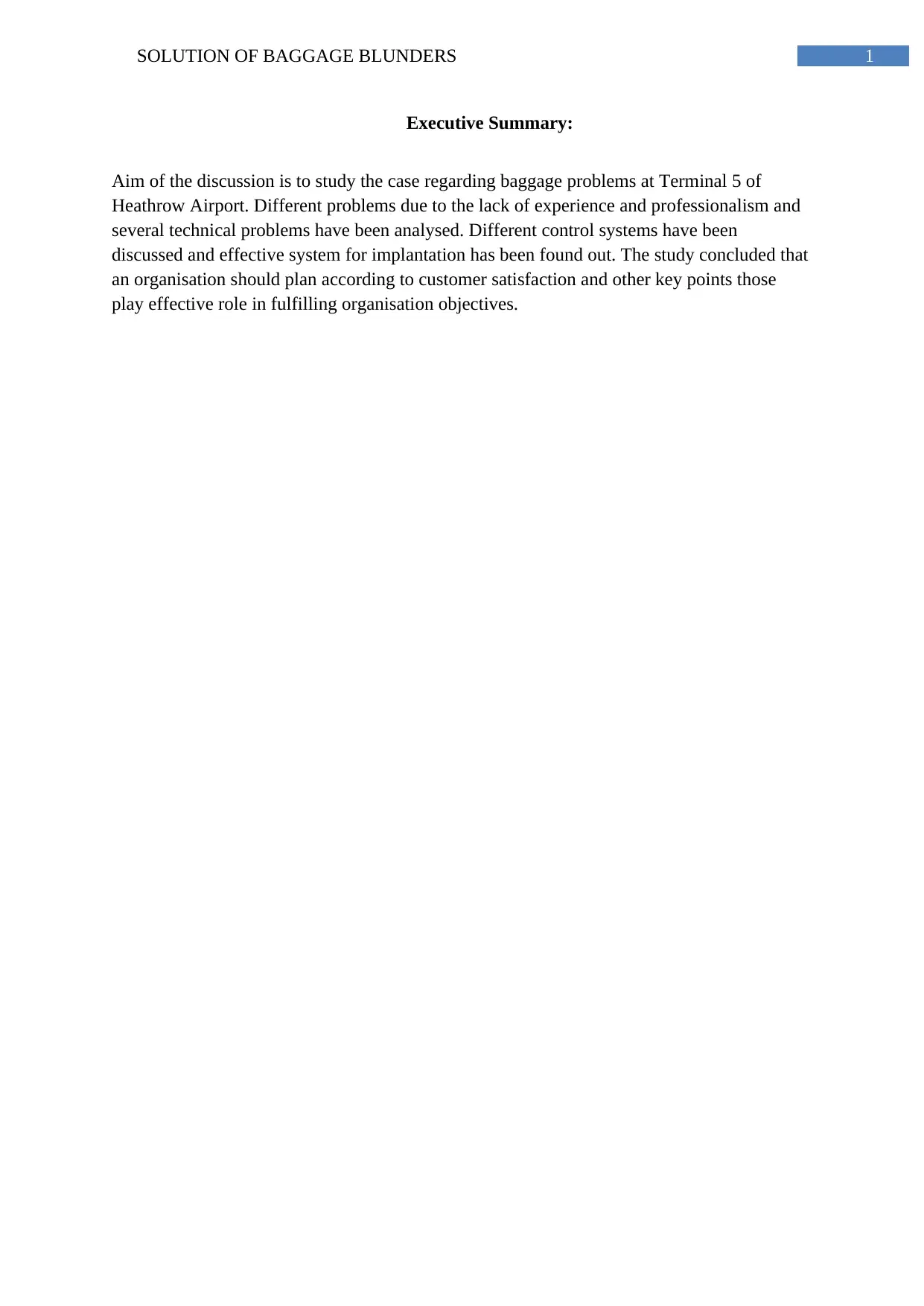
1SOLUTION OF BAGGAGE BLUNDERS
Executive Summary:
Aim of the discussion is to study the case regarding baggage problems at Terminal 5 of
Heathrow Airport. Different problems due to the lack of experience and professionalism and
several technical problems have been analysed. Different control systems have been
discussed and effective system for implantation has been found out. The study concluded that
an organisation should plan according to customer satisfaction and other key points those
play effective role in fulfilling organisation objectives.
Executive Summary:
Aim of the discussion is to study the case regarding baggage problems at Terminal 5 of
Heathrow Airport. Different problems due to the lack of experience and professionalism and
several technical problems have been analysed. Different control systems have been
discussed and effective system for implantation has been found out. The study concluded that
an organisation should plan according to customer satisfaction and other key points those
play effective role in fulfilling organisation objectives.
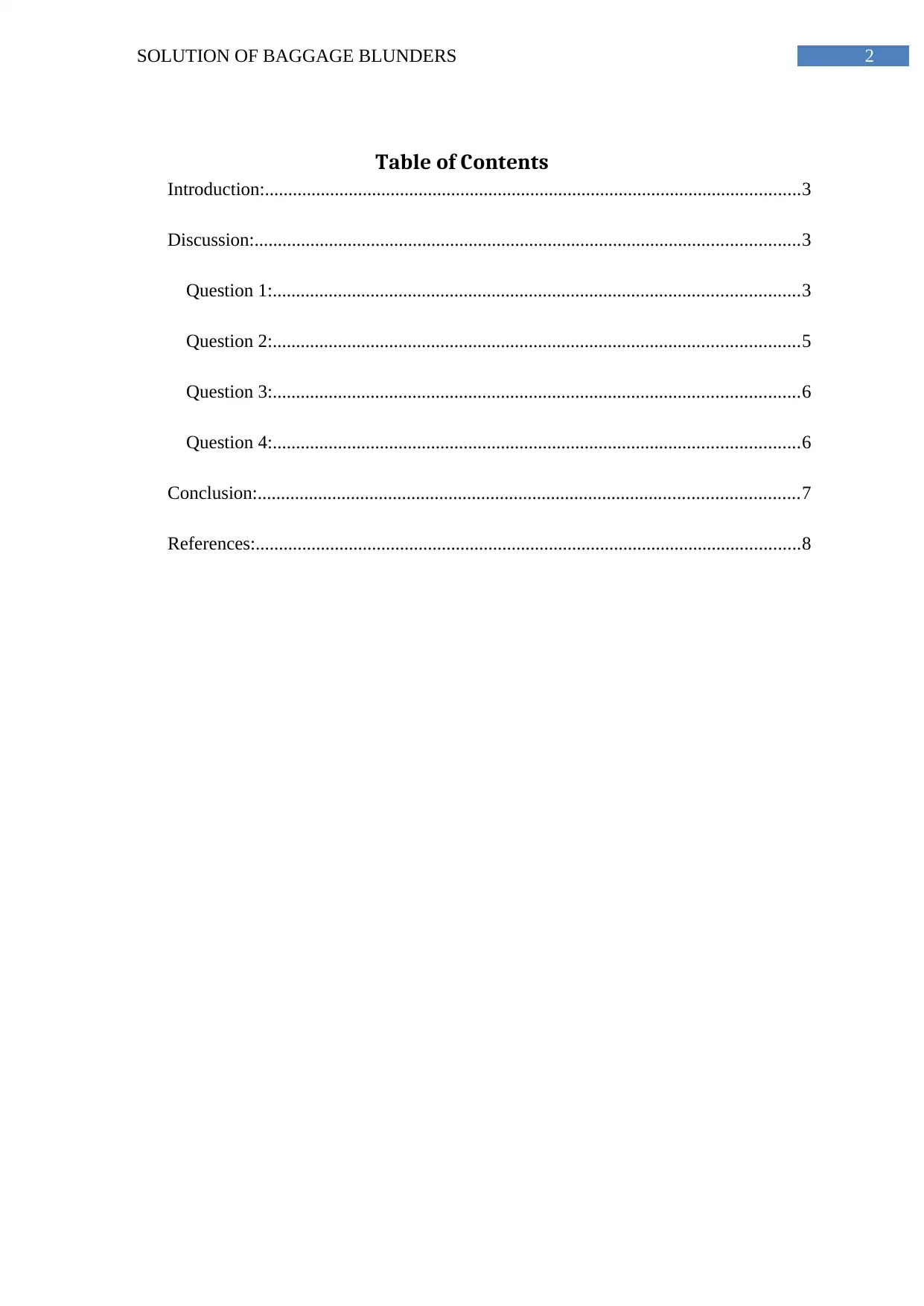
2SOLUTION OF BAGGAGE BLUNDERS
Table of Contents
Introduction:...................................................................................................................3
Discussion:.....................................................................................................................3
Question 1:.................................................................................................................3
Question 2:.................................................................................................................5
Question 3:.................................................................................................................6
Question 4:.................................................................................................................6
Conclusion:....................................................................................................................7
References:.....................................................................................................................8
Table of Contents
Introduction:...................................................................................................................3
Discussion:.....................................................................................................................3
Question 1:.................................................................................................................3
Question 2:.................................................................................................................5
Question 3:.................................................................................................................6
Question 4:.................................................................................................................6
Conclusion:....................................................................................................................7
References:.....................................................................................................................8
⊘ This is a preview!⊘
Do you want full access?
Subscribe today to unlock all pages.

Trusted by 1+ million students worldwide
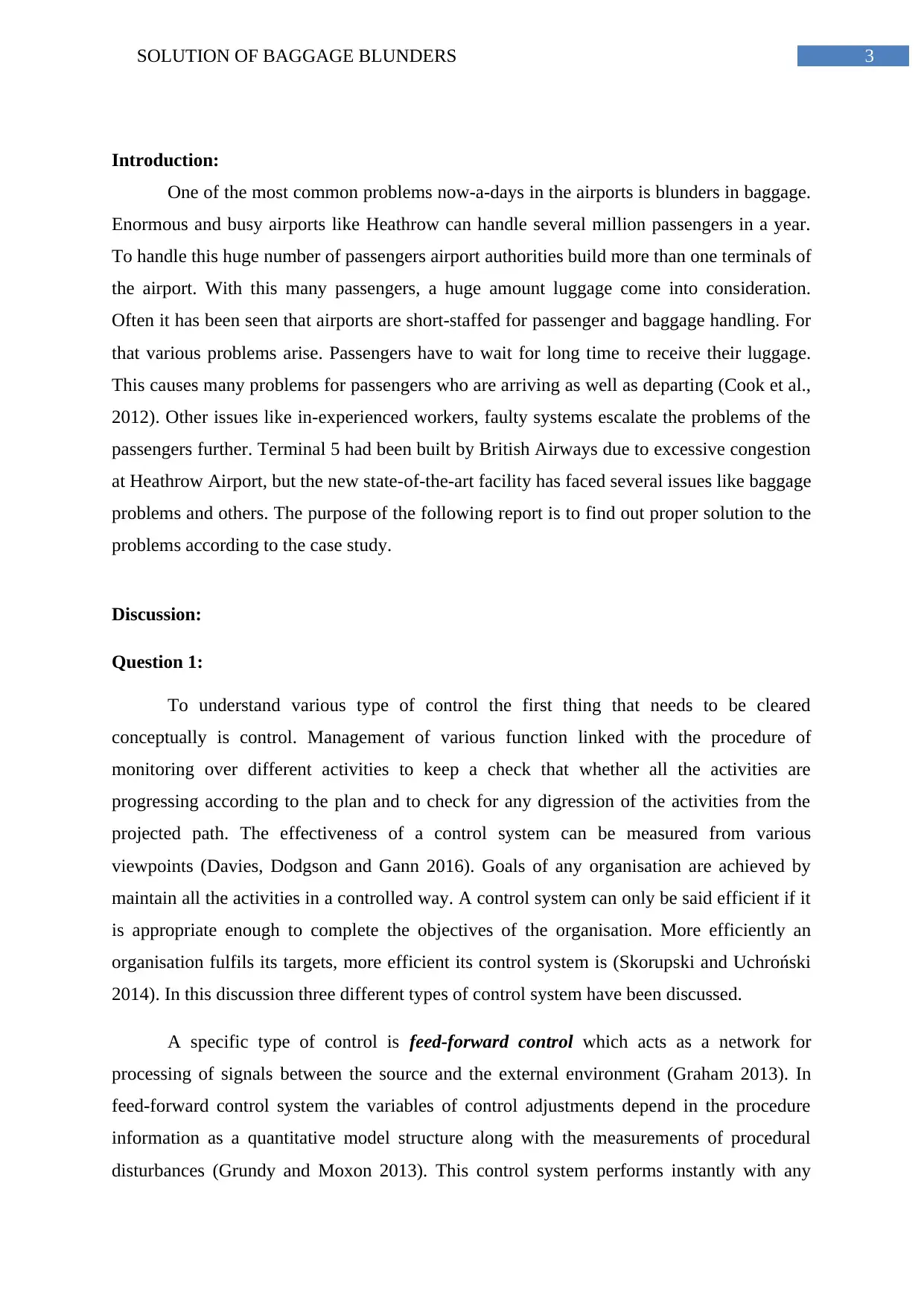
3SOLUTION OF BAGGAGE BLUNDERS
Introduction:
One of the most common problems now-a-days in the airports is blunders in baggage.
Enormous and busy airports like Heathrow can handle several million passengers in a year.
To handle this huge number of passengers airport authorities build more than one terminals of
the airport. With this many passengers, a huge amount luggage come into consideration.
Often it has been seen that airports are short-staffed for passenger and baggage handling. For
that various problems arise. Passengers have to wait for long time to receive their luggage.
This causes many problems for passengers who are arriving as well as departing (Cook et al.,
2012). Other issues like in-experienced workers, faulty systems escalate the problems of the
passengers further. Terminal 5 had been built by British Airways due to excessive congestion
at Heathrow Airport, but the new state-of-the-art facility has faced several issues like baggage
problems and others. The purpose of the following report is to find out proper solution to the
problems according to the case study.
Discussion:
Question 1:
To understand various type of control the first thing that needs to be cleared
conceptually is control. Management of various function linked with the procedure of
monitoring over different activities to keep a check that whether all the activities are
progressing according to the plan and to check for any digression of the activities from the
projected path. The effectiveness of a control system can be measured from various
viewpoints (Davies, Dodgson and Gann 2016). Goals of any organisation are achieved by
maintain all the activities in a controlled way. A control system can only be said efficient if it
is appropriate enough to complete the objectives of the organisation. More efficiently an
organisation fulfils its targets, more efficient its control system is (Skorupski and Uchroński
2014). In this discussion three different types of control system have been discussed.
A specific type of control is feed-forward control which acts as a network for
processing of signals between the source and the external environment (Graham 2013). In
feed-forward control system the variables of control adjustments depend in the procedure
information as a quantitative model structure along with the measurements of procedural
disturbances (Grundy and Moxon 2013). This control system performs instantly with any
Introduction:
One of the most common problems now-a-days in the airports is blunders in baggage.
Enormous and busy airports like Heathrow can handle several million passengers in a year.
To handle this huge number of passengers airport authorities build more than one terminals of
the airport. With this many passengers, a huge amount luggage come into consideration.
Often it has been seen that airports are short-staffed for passenger and baggage handling. For
that various problems arise. Passengers have to wait for long time to receive their luggage.
This causes many problems for passengers who are arriving as well as departing (Cook et al.,
2012). Other issues like in-experienced workers, faulty systems escalate the problems of the
passengers further. Terminal 5 had been built by British Airways due to excessive congestion
at Heathrow Airport, but the new state-of-the-art facility has faced several issues like baggage
problems and others. The purpose of the following report is to find out proper solution to the
problems according to the case study.
Discussion:
Question 1:
To understand various type of control the first thing that needs to be cleared
conceptually is control. Management of various function linked with the procedure of
monitoring over different activities to keep a check that whether all the activities are
progressing according to the plan and to check for any digression of the activities from the
projected path. The effectiveness of a control system can be measured from various
viewpoints (Davies, Dodgson and Gann 2016). Goals of any organisation are achieved by
maintain all the activities in a controlled way. A control system can only be said efficient if it
is appropriate enough to complete the objectives of the organisation. More efficiently an
organisation fulfils its targets, more efficient its control system is (Skorupski and Uchroński
2014). In this discussion three different types of control system have been discussed.
A specific type of control is feed-forward control which acts as a network for
processing of signals between the source and the external environment (Graham 2013). In
feed-forward control system the variables of control adjustments depend in the procedure
information as a quantitative model structure along with the measurements of procedural
disturbances (Grundy and Moxon 2013). This control system performs instantly with any
Paraphrase This Document
Need a fresh take? Get an instant paraphrase of this document with our AI Paraphraser
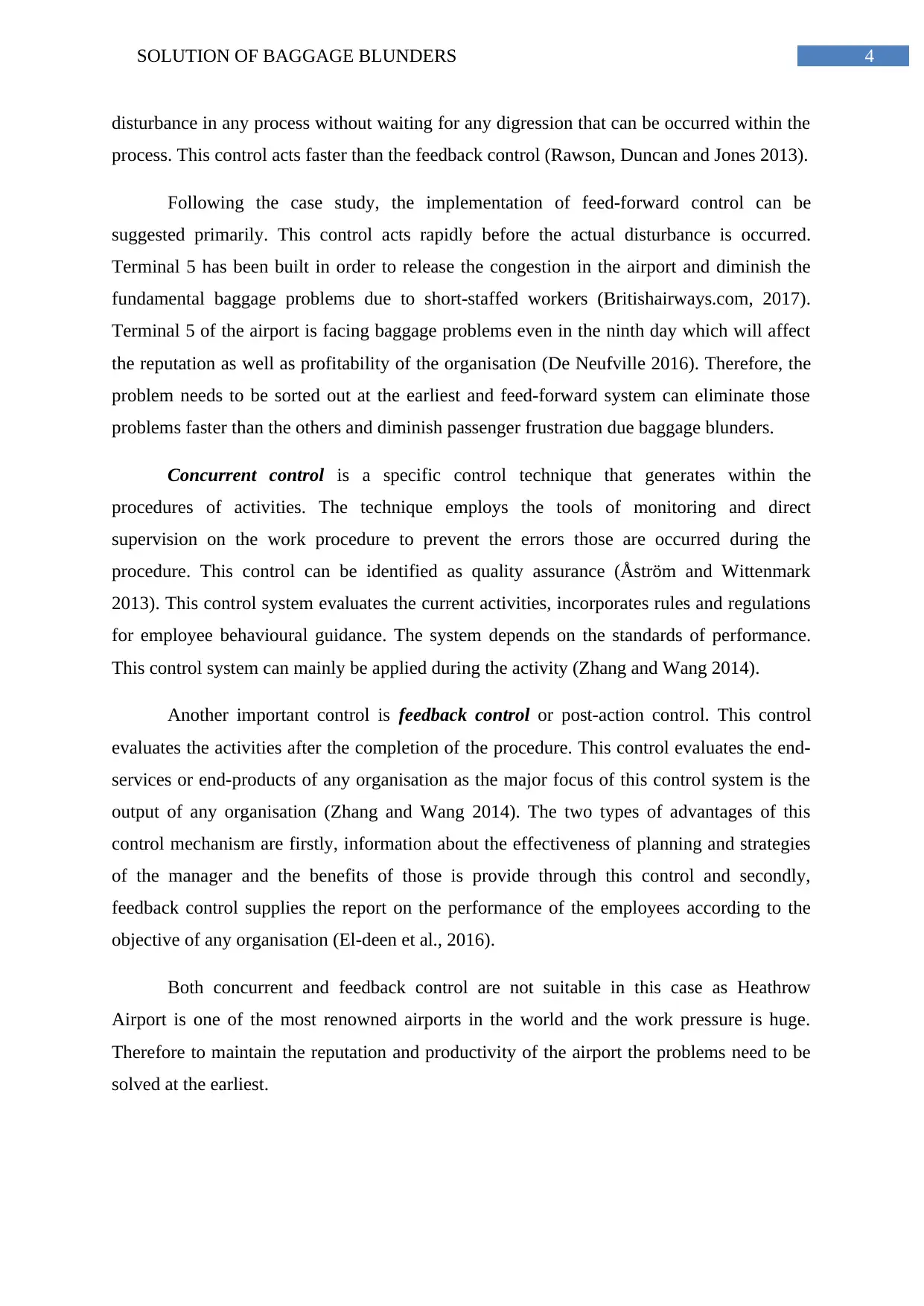
4SOLUTION OF BAGGAGE BLUNDERS
disturbance in any process without waiting for any digression that can be occurred within the
process. This control acts faster than the feedback control (Rawson, Duncan and Jones 2013).
Following the case study, the implementation of feed-forward control can be
suggested primarily. This control acts rapidly before the actual disturbance is occurred.
Terminal 5 has been built in order to release the congestion in the airport and diminish the
fundamental baggage problems due to short-staffed workers (Britishairways.com, 2017).
Terminal 5 of the airport is facing baggage problems even in the ninth day which will affect
the reputation as well as profitability of the organisation (De Neufville 2016). Therefore, the
problem needs to be sorted out at the earliest and feed-forward system can eliminate those
problems faster than the others and diminish passenger frustration due baggage blunders.
Concurrent control is a specific control technique that generates within the
procedures of activities. The technique employs the tools of monitoring and direct
supervision on the work procedure to prevent the errors those are occurred during the
procedure. This control can be identified as quality assurance (Åström and Wittenmark
2013). This control system evaluates the current activities, incorporates rules and regulations
for employee behavioural guidance. The system depends on the standards of performance.
This control system can mainly be applied during the activity (Zhang and Wang 2014).
Another important control is feedback control or post-action control. This control
evaluates the activities after the completion of the procedure. This control evaluates the end-
services or end-products of any organisation as the major focus of this control system is the
output of any organisation (Zhang and Wang 2014). The two types of advantages of this
control mechanism are firstly, information about the effectiveness of planning and strategies
of the manager and the benefits of those is provide through this control and secondly,
feedback control supplies the report on the performance of the employees according to the
objective of any organisation (El-deen et al., 2016).
Both concurrent and feedback control are not suitable in this case as Heathrow
Airport is one of the most renowned airports in the world and the work pressure is huge.
Therefore to maintain the reputation and productivity of the airport the problems need to be
solved at the earliest.
disturbance in any process without waiting for any digression that can be occurred within the
process. This control acts faster than the feedback control (Rawson, Duncan and Jones 2013).
Following the case study, the implementation of feed-forward control can be
suggested primarily. This control acts rapidly before the actual disturbance is occurred.
Terminal 5 has been built in order to release the congestion in the airport and diminish the
fundamental baggage problems due to short-staffed workers (Britishairways.com, 2017).
Terminal 5 of the airport is facing baggage problems even in the ninth day which will affect
the reputation as well as profitability of the organisation (De Neufville 2016). Therefore, the
problem needs to be sorted out at the earliest and feed-forward system can eliminate those
problems faster than the others and diminish passenger frustration due baggage blunders.
Concurrent control is a specific control technique that generates within the
procedures of activities. The technique employs the tools of monitoring and direct
supervision on the work procedure to prevent the errors those are occurred during the
procedure. This control can be identified as quality assurance (Åström and Wittenmark
2013). This control system evaluates the current activities, incorporates rules and regulations
for employee behavioural guidance. The system depends on the standards of performance.
This control system can mainly be applied during the activity (Zhang and Wang 2014).
Another important control is feedback control or post-action control. This control
evaluates the activities after the completion of the procedure. This control evaluates the end-
services or end-products of any organisation as the major focus of this control system is the
output of any organisation (Zhang and Wang 2014). The two types of advantages of this
control mechanism are firstly, information about the effectiveness of planning and strategies
of the manager and the benefits of those is provide through this control and secondly,
feedback control supplies the report on the performance of the employees according to the
objective of any organisation (El-deen et al., 2016).
Both concurrent and feedback control are not suitable in this case as Heathrow
Airport is one of the most renowned airports in the world and the work pressure is huge.
Therefore to maintain the reputation and productivity of the airport the problems need to be
solved at the earliest.
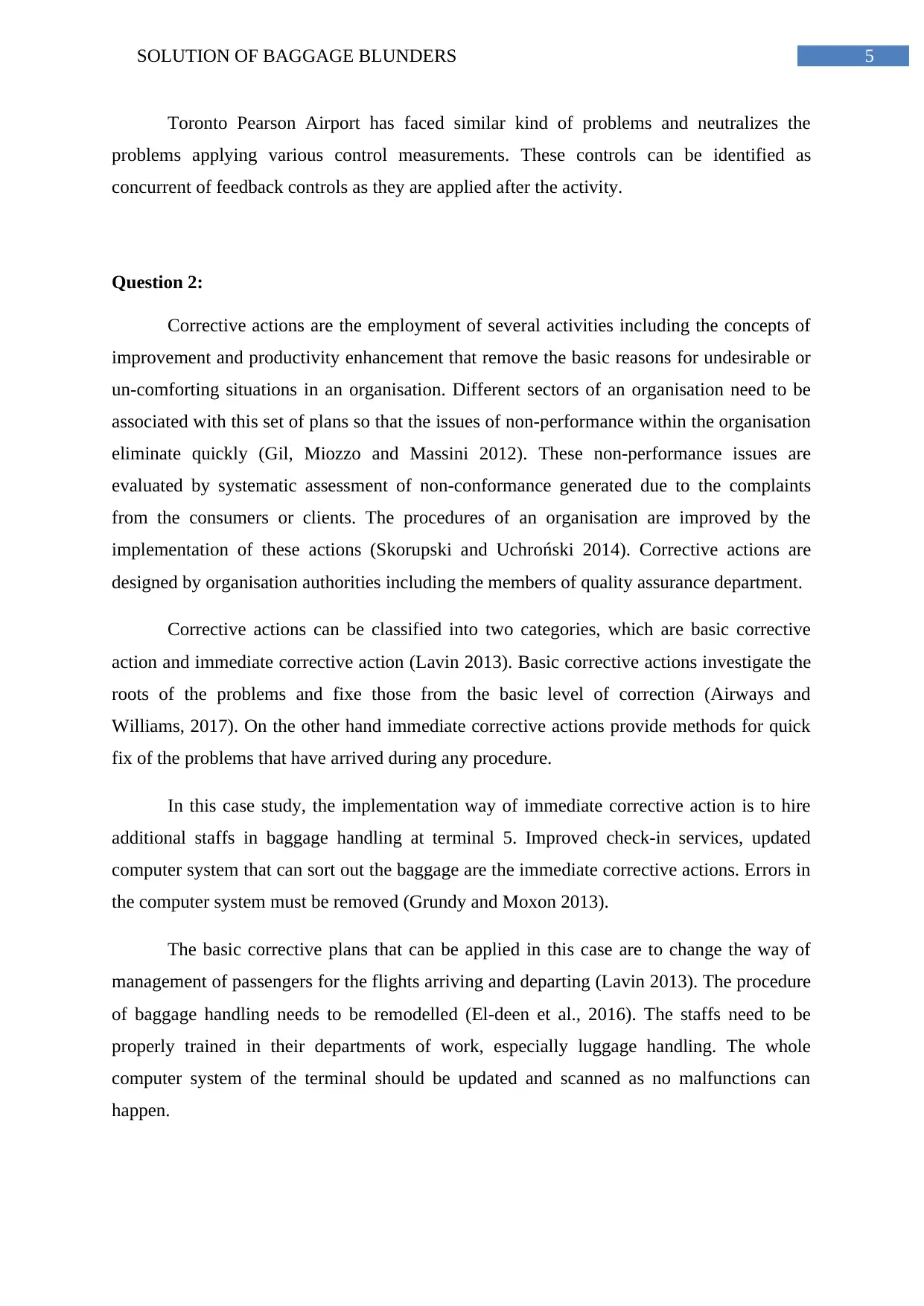
5SOLUTION OF BAGGAGE BLUNDERS
Toronto Pearson Airport has faced similar kind of problems and neutralizes the
problems applying various control measurements. These controls can be identified as
concurrent of feedback controls as they are applied after the activity.
Question 2:
Corrective actions are the employment of several activities including the concepts of
improvement and productivity enhancement that remove the basic reasons for undesirable or
un-comforting situations in an organisation. Different sectors of an organisation need to be
associated with this set of plans so that the issues of non-performance within the organisation
eliminate quickly (Gil, Miozzo and Massini 2012). These non-performance issues are
evaluated by systematic assessment of non-conformance generated due to the complaints
from the consumers or clients. The procedures of an organisation are improved by the
implementation of these actions (Skorupski and Uchroński 2014). Corrective actions are
designed by organisation authorities including the members of quality assurance department.
Corrective actions can be classified into two categories, which are basic corrective
action and immediate corrective action (Lavin 2013). Basic corrective actions investigate the
roots of the problems and fixe those from the basic level of correction (Airways and
Williams, 2017). On the other hand immediate corrective actions provide methods for quick
fix of the problems that have arrived during any procedure.
In this case study, the implementation way of immediate corrective action is to hire
additional staffs in baggage handling at terminal 5. Improved check-in services, updated
computer system that can sort out the baggage are the immediate corrective actions. Errors in
the computer system must be removed (Grundy and Moxon 2013).
The basic corrective plans that can be applied in this case are to change the way of
management of passengers for the flights arriving and departing (Lavin 2013). The procedure
of baggage handling needs to be remodelled (El-deen et al., 2016). The staffs need to be
properly trained in their departments of work, especially luggage handling. The whole
computer system of the terminal should be updated and scanned as no malfunctions can
happen.
Toronto Pearson Airport has faced similar kind of problems and neutralizes the
problems applying various control measurements. These controls can be identified as
concurrent of feedback controls as they are applied after the activity.
Question 2:
Corrective actions are the employment of several activities including the concepts of
improvement and productivity enhancement that remove the basic reasons for undesirable or
un-comforting situations in an organisation. Different sectors of an organisation need to be
associated with this set of plans so that the issues of non-performance within the organisation
eliminate quickly (Gil, Miozzo and Massini 2012). These non-performance issues are
evaluated by systematic assessment of non-conformance generated due to the complaints
from the consumers or clients. The procedures of an organisation are improved by the
implementation of these actions (Skorupski and Uchroński 2014). Corrective actions are
designed by organisation authorities including the members of quality assurance department.
Corrective actions can be classified into two categories, which are basic corrective
action and immediate corrective action (Lavin 2013). Basic corrective actions investigate the
roots of the problems and fixe those from the basic level of correction (Airways and
Williams, 2017). On the other hand immediate corrective actions provide methods for quick
fix of the problems that have arrived during any procedure.
In this case study, the implementation way of immediate corrective action is to hire
additional staffs in baggage handling at terminal 5. Improved check-in services, updated
computer system that can sort out the baggage are the immediate corrective actions. Errors in
the computer system must be removed (Grundy and Moxon 2013).
The basic corrective plans that can be applied in this case are to change the way of
management of passengers for the flights arriving and departing (Lavin 2013). The procedure
of baggage handling needs to be remodelled (El-deen et al., 2016). The staffs need to be
properly trained in their departments of work, especially luggage handling. The whole
computer system of the terminal should be updated and scanned as no malfunctions can
happen.
⊘ This is a preview!⊘
Do you want full access?
Subscribe today to unlock all pages.

Trusted by 1+ million students worldwide
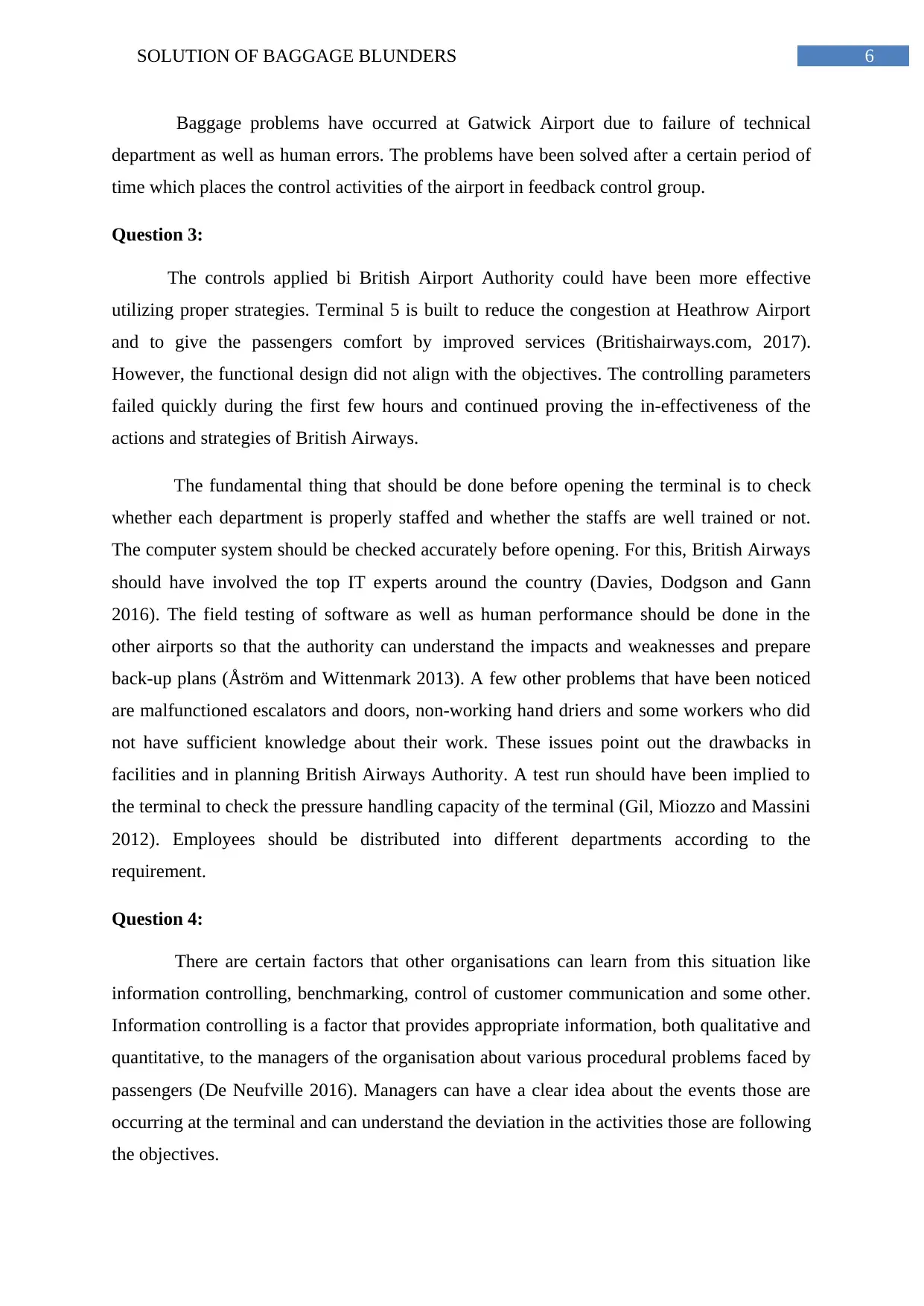
6SOLUTION OF BAGGAGE BLUNDERS
Baggage problems have occurred at Gatwick Airport due to failure of technical
department as well as human errors. The problems have been solved after a certain period of
time which places the control activities of the airport in feedback control group.
Question 3:
The controls applied bi British Airport Authority could have been more effective
utilizing proper strategies. Terminal 5 is built to reduce the congestion at Heathrow Airport
and to give the passengers comfort by improved services (Britishairways.com, 2017).
However, the functional design did not align with the objectives. The controlling parameters
failed quickly during the first few hours and continued proving the in-effectiveness of the
actions and strategies of British Airways.
The fundamental thing that should be done before opening the terminal is to check
whether each department is properly staffed and whether the staffs are well trained or not.
The computer system should be checked accurately before opening. For this, British Airways
should have involved the top IT experts around the country (Davies, Dodgson and Gann
2016). The field testing of software as well as human performance should be done in the
other airports so that the authority can understand the impacts and weaknesses and prepare
back-up plans (Åström and Wittenmark 2013). A few other problems that have been noticed
are malfunctioned escalators and doors, non-working hand driers and some workers who did
not have sufficient knowledge about their work. These issues point out the drawbacks in
facilities and in planning British Airways Authority. A test run should have been implied to
the terminal to check the pressure handling capacity of the terminal (Gil, Miozzo and Massini
2012). Employees should be distributed into different departments according to the
requirement.
Question 4:
There are certain factors that other organisations can learn from this situation like
information controlling, benchmarking, control of customer communication and some other.
Information controlling is a factor that provides appropriate information, both qualitative and
quantitative, to the managers of the organisation about various procedural problems faced by
passengers (De Neufville 2016). Managers can have a clear idea about the events those are
occurring at the terminal and can understand the deviation in the activities those are following
the objectives.
Baggage problems have occurred at Gatwick Airport due to failure of technical
department as well as human errors. The problems have been solved after a certain period of
time which places the control activities of the airport in feedback control group.
Question 3:
The controls applied bi British Airport Authority could have been more effective
utilizing proper strategies. Terminal 5 is built to reduce the congestion at Heathrow Airport
and to give the passengers comfort by improved services (Britishairways.com, 2017).
However, the functional design did not align with the objectives. The controlling parameters
failed quickly during the first few hours and continued proving the in-effectiveness of the
actions and strategies of British Airways.
The fundamental thing that should be done before opening the terminal is to check
whether each department is properly staffed and whether the staffs are well trained or not.
The computer system should be checked accurately before opening. For this, British Airways
should have involved the top IT experts around the country (Davies, Dodgson and Gann
2016). The field testing of software as well as human performance should be done in the
other airports so that the authority can understand the impacts and weaknesses and prepare
back-up plans (Åström and Wittenmark 2013). A few other problems that have been noticed
are malfunctioned escalators and doors, non-working hand driers and some workers who did
not have sufficient knowledge about their work. These issues point out the drawbacks in
facilities and in planning British Airways Authority. A test run should have been implied to
the terminal to check the pressure handling capacity of the terminal (Gil, Miozzo and Massini
2012). Employees should be distributed into different departments according to the
requirement.
Question 4:
There are certain factors that other organisations can learn from this situation like
information controlling, benchmarking, control of customer communication and some other.
Information controlling is a factor that provides appropriate information, both qualitative and
quantitative, to the managers of the organisation about various procedural problems faced by
passengers (De Neufville 2016). Managers can have a clear idea about the events those are
occurring at the terminal and can understand the deviation in the activities those are following
the objectives.
Paraphrase This Document
Need a fresh take? Get an instant paraphrase of this document with our AI Paraphraser
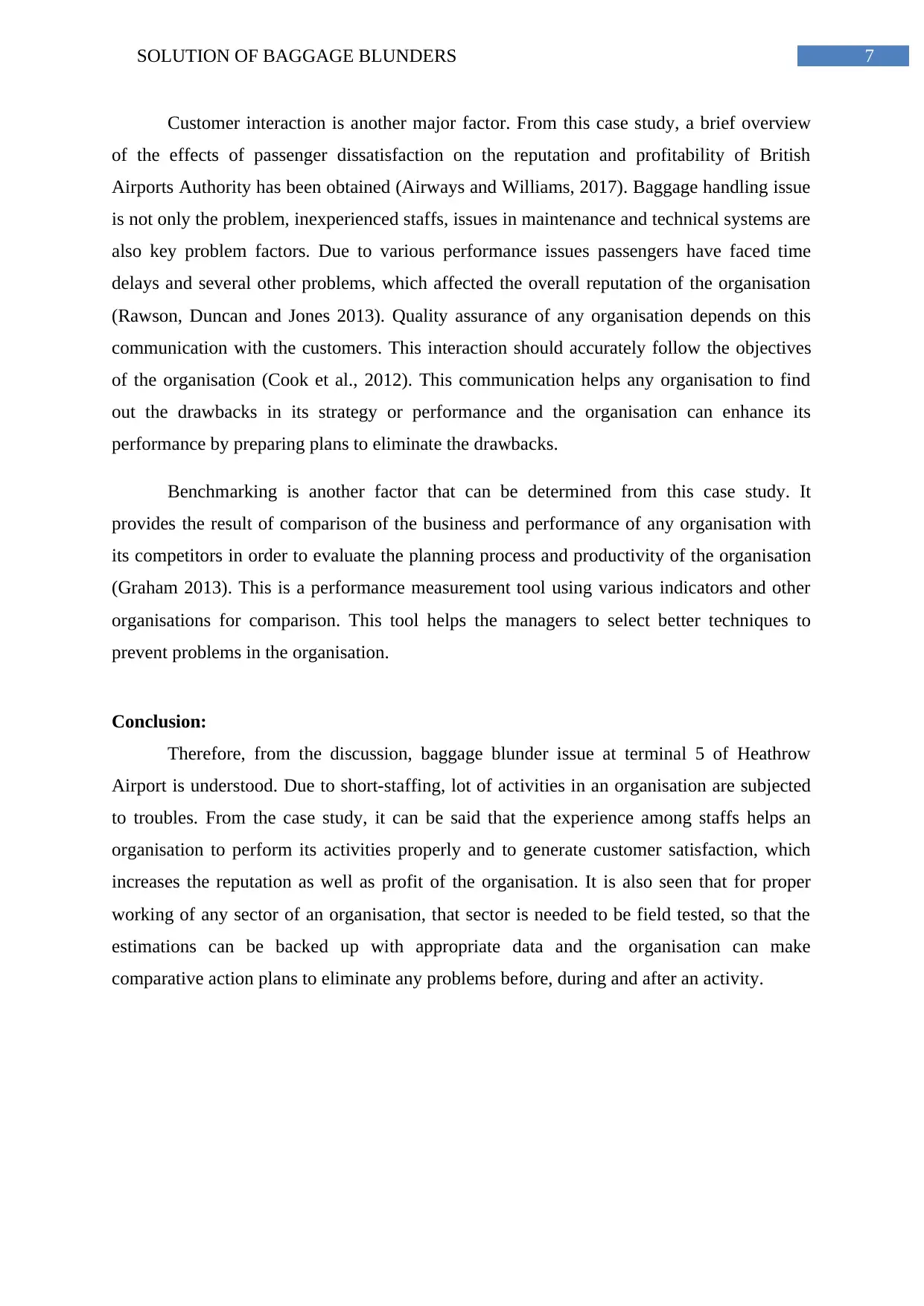
7SOLUTION OF BAGGAGE BLUNDERS
Customer interaction is another major factor. From this case study, a brief overview
of the effects of passenger dissatisfaction on the reputation and profitability of British
Airports Authority has been obtained (Airways and Williams, 2017). Baggage handling issue
is not only the problem, inexperienced staffs, issues in maintenance and technical systems are
also key problem factors. Due to various performance issues passengers have faced time
delays and several other problems, which affected the overall reputation of the organisation
(Rawson, Duncan and Jones 2013). Quality assurance of any organisation depends on this
communication with the customers. This interaction should accurately follow the objectives
of the organisation (Cook et al., 2012). This communication helps any organisation to find
out the drawbacks in its strategy or performance and the organisation can enhance its
performance by preparing plans to eliminate the drawbacks.
Benchmarking is another factor that can be determined from this case study. It
provides the result of comparison of the business and performance of any organisation with
its competitors in order to evaluate the planning process and productivity of the organisation
(Graham 2013). This is a performance measurement tool using various indicators and other
organisations for comparison. This tool helps the managers to select better techniques to
prevent problems in the organisation.
Conclusion:
Therefore, from the discussion, baggage blunder issue at terminal 5 of Heathrow
Airport is understood. Due to short-staffing, lot of activities in an organisation are subjected
to troubles. From the case study, it can be said that the experience among staffs helps an
organisation to perform its activities properly and to generate customer satisfaction, which
increases the reputation as well as profit of the organisation. It is also seen that for proper
working of any sector of an organisation, that sector is needed to be field tested, so that the
estimations can be backed up with appropriate data and the organisation can make
comparative action plans to eliminate any problems before, during and after an activity.
Customer interaction is another major factor. From this case study, a brief overview
of the effects of passenger dissatisfaction on the reputation and profitability of British
Airports Authority has been obtained (Airways and Williams, 2017). Baggage handling issue
is not only the problem, inexperienced staffs, issues in maintenance and technical systems are
also key problem factors. Due to various performance issues passengers have faced time
delays and several other problems, which affected the overall reputation of the organisation
(Rawson, Duncan and Jones 2013). Quality assurance of any organisation depends on this
communication with the customers. This interaction should accurately follow the objectives
of the organisation (Cook et al., 2012). This communication helps any organisation to find
out the drawbacks in its strategy or performance and the organisation can enhance its
performance by preparing plans to eliminate the drawbacks.
Benchmarking is another factor that can be determined from this case study. It
provides the result of comparison of the business and performance of any organisation with
its competitors in order to evaluate the planning process and productivity of the organisation
(Graham 2013). This is a performance measurement tool using various indicators and other
organisations for comparison. This tool helps the managers to select better techniques to
prevent problems in the organisation.
Conclusion:
Therefore, from the discussion, baggage blunder issue at terminal 5 of Heathrow
Airport is understood. Due to short-staffing, lot of activities in an organisation are subjected
to troubles. From the case study, it can be said that the experience among staffs helps an
organisation to perform its activities properly and to generate customer satisfaction, which
increases the reputation as well as profit of the organisation. It is also seen that for proper
working of any sector of an organisation, that sector is needed to be field tested, so that the
estimations can be backed up with appropriate data and the organisation can make
comparative action plans to eliminate any problems before, during and after an activity.
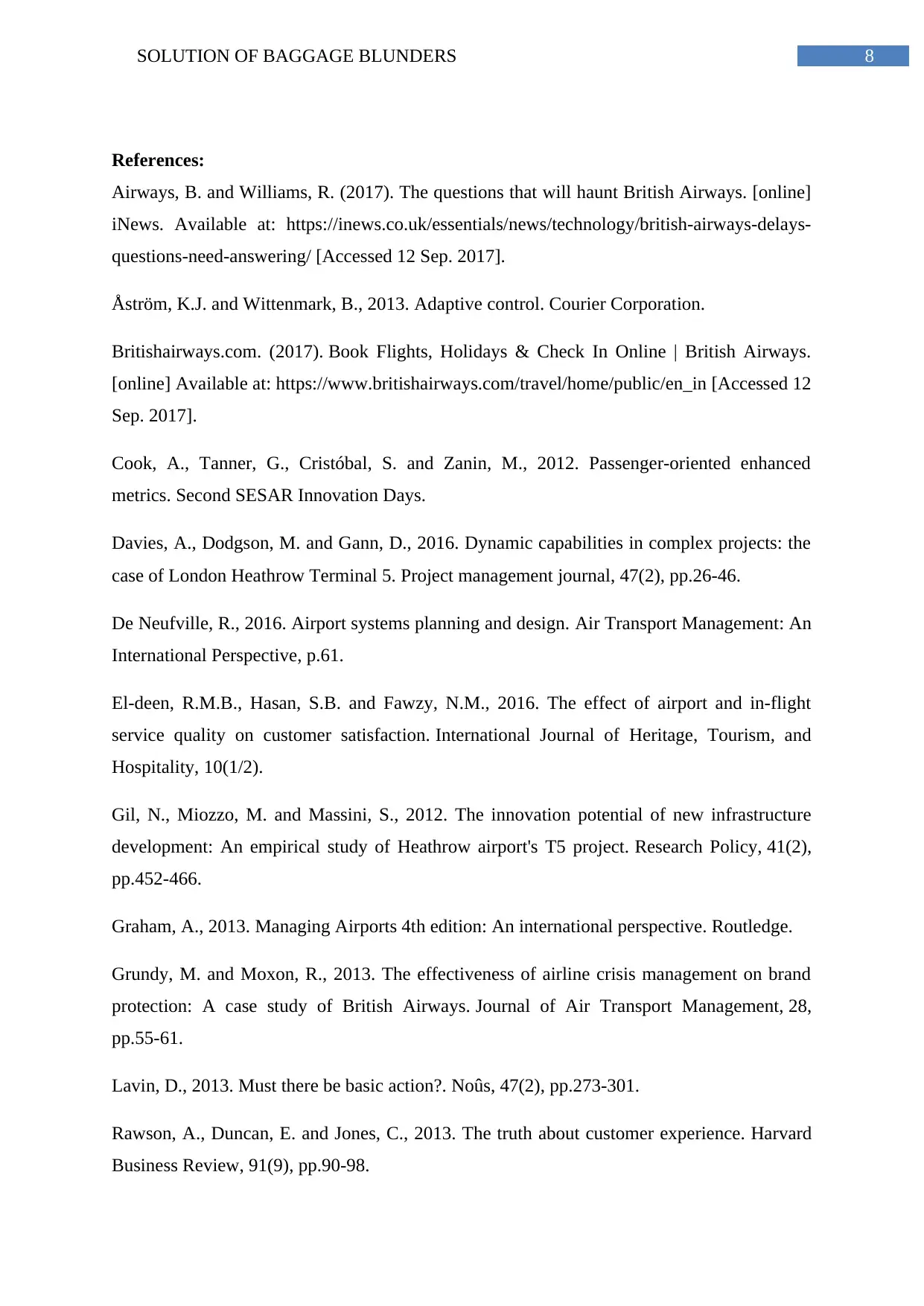
8SOLUTION OF BAGGAGE BLUNDERS
References:
Airways, B. and Williams, R. (2017). The questions that will haunt British Airways. [online]
iNews. Available at: https://inews.co.uk/essentials/news/technology/british-airways-delays-
questions-need-answering/ [Accessed 12 Sep. 2017].
Åström, K.J. and Wittenmark, B., 2013. Adaptive control. Courier Corporation.
Britishairways.com. (2017). Book Flights, Holidays & Check In Online | British Airways.
[online] Available at: https://www.britishairways.com/travel/home/public/en_in [Accessed 12
Sep. 2017].
Cook, A., Tanner, G., Cristóbal, S. and Zanin, M., 2012. Passenger-oriented enhanced
metrics. Second SESAR Innovation Days.
Davies, A., Dodgson, M. and Gann, D., 2016. Dynamic capabilities in complex projects: the
case of London Heathrow Terminal 5. Project management journal, 47(2), pp.26-46.
De Neufville, R., 2016. Airport systems planning and design. Air Transport Management: An
International Perspective, p.61.
El-deen, R.M.B., Hasan, S.B. and Fawzy, N.M., 2016. The effect of airport and in-flight
service quality on customer satisfaction. International Journal of Heritage, Tourism, and
Hospitality, 10(1/2).
Gil, N., Miozzo, M. and Massini, S., 2012. The innovation potential of new infrastructure
development: An empirical study of Heathrow airport's T5 project. Research Policy, 41(2),
pp.452-466.
Graham, A., 2013. Managing Airports 4th edition: An international perspective. Routledge.
Grundy, M. and Moxon, R., 2013. The effectiveness of airline crisis management on brand
protection: A case study of British Airways. Journal of Air Transport Management, 28,
pp.55-61.
Lavin, D., 2013. Must there be basic action?. Noûs, 47(2), pp.273-301.
Rawson, A., Duncan, E. and Jones, C., 2013. The truth about customer experience. Harvard
Business Review, 91(9), pp.90-98.
References:
Airways, B. and Williams, R. (2017). The questions that will haunt British Airways. [online]
iNews. Available at: https://inews.co.uk/essentials/news/technology/british-airways-delays-
questions-need-answering/ [Accessed 12 Sep. 2017].
Åström, K.J. and Wittenmark, B., 2013. Adaptive control. Courier Corporation.
Britishairways.com. (2017). Book Flights, Holidays & Check In Online | British Airways.
[online] Available at: https://www.britishairways.com/travel/home/public/en_in [Accessed 12
Sep. 2017].
Cook, A., Tanner, G., Cristóbal, S. and Zanin, M., 2012. Passenger-oriented enhanced
metrics. Second SESAR Innovation Days.
Davies, A., Dodgson, M. and Gann, D., 2016. Dynamic capabilities in complex projects: the
case of London Heathrow Terminal 5. Project management journal, 47(2), pp.26-46.
De Neufville, R., 2016. Airport systems planning and design. Air Transport Management: An
International Perspective, p.61.
El-deen, R.M.B., Hasan, S.B. and Fawzy, N.M., 2016. The effect of airport and in-flight
service quality on customer satisfaction. International Journal of Heritage, Tourism, and
Hospitality, 10(1/2).
Gil, N., Miozzo, M. and Massini, S., 2012. The innovation potential of new infrastructure
development: An empirical study of Heathrow airport's T5 project. Research Policy, 41(2),
pp.452-466.
Graham, A., 2013. Managing Airports 4th edition: An international perspective. Routledge.
Grundy, M. and Moxon, R., 2013. The effectiveness of airline crisis management on brand
protection: A case study of British Airways. Journal of Air Transport Management, 28,
pp.55-61.
Lavin, D., 2013. Must there be basic action?. Noûs, 47(2), pp.273-301.
Rawson, A., Duncan, E. and Jones, C., 2013. The truth about customer experience. Harvard
Business Review, 91(9), pp.90-98.
⊘ This is a preview!⊘
Do you want full access?
Subscribe today to unlock all pages.

Trusted by 1+ million students worldwide
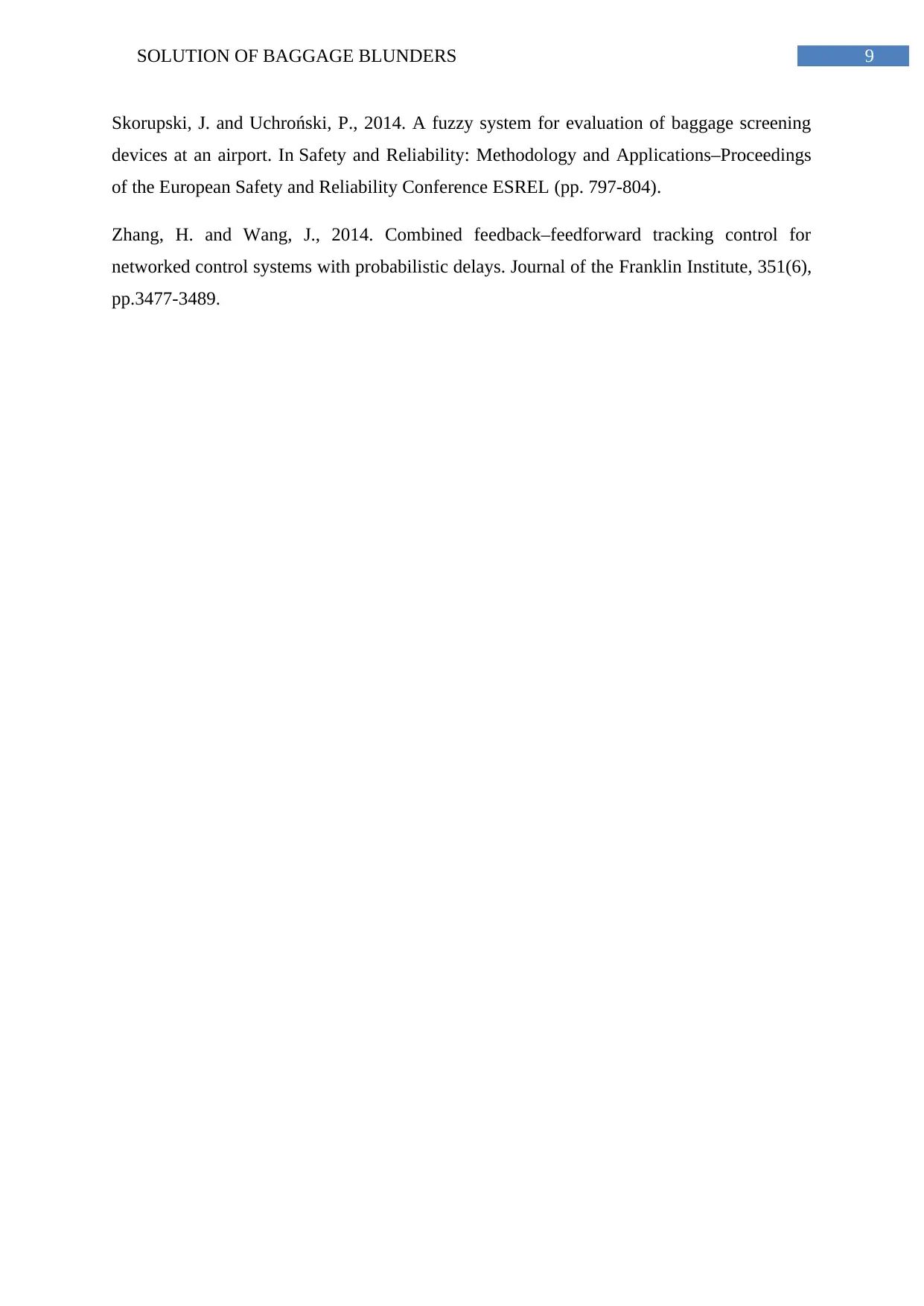
9SOLUTION OF BAGGAGE BLUNDERS
Skorupski, J. and Uchroński, P., 2014. A fuzzy system for evaluation of baggage screening
devices at an airport. In Safety and Reliability: Methodology and Applications–Proceedings
of the European Safety and Reliability Conference ESREL (pp. 797-804).
Zhang, H. and Wang, J., 2014. Combined feedback–feedforward tracking control for
networked control systems with probabilistic delays. Journal of the Franklin Institute, 351(6),
pp.3477-3489.
Skorupski, J. and Uchroński, P., 2014. A fuzzy system for evaluation of baggage screening
devices at an airport. In Safety and Reliability: Methodology and Applications–Proceedings
of the European Safety and Reliability Conference ESREL (pp. 797-804).
Zhang, H. and Wang, J., 2014. Combined feedback–feedforward tracking control for
networked control systems with probabilistic delays. Journal of the Franklin Institute, 351(6),
pp.3477-3489.
1 out of 10
Related Documents
Your All-in-One AI-Powered Toolkit for Academic Success.
+13062052269
info@desklib.com
Available 24*7 on WhatsApp / Email
![[object Object]](/_next/static/media/star-bottom.7253800d.svg)
Unlock your academic potential
Copyright © 2020–2025 A2Z Services. All Rights Reserved. Developed and managed by ZUCOL.




